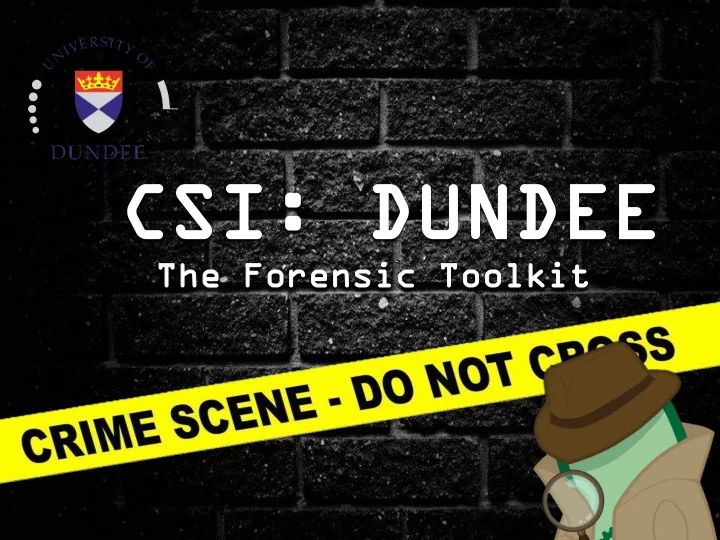

CS CSI: I: DUND DUNDEE EE Th The e Fo Fore rensic nsic To Tool olkit kit
Meet the Team
Meet the Team
What is Forensic Science?
What is Forensic Science?
Why Forensic Science?
Why Forensic Science?
Why Forensic Science?
Why Forensic Science? “There is Forensics and then there is Science .” Sue Black – OBE, FRSE, Director of CAHID and Professor of Anatomy and Forensic Anthropology at the University of Dundee
Public blic Perception: rception: The e CSI Effect fect
Public blic Perception: rception: The e CSI Effect fect
Public blic Perception: rception: The e CSI Effect fect
Why Forensic Science?
The Experts Home Office Centre for Applied Science and Technology (CAST) Chemist
Meeting the Experts NAME: Prof. Niamh Nic Daeid TITLE: Professor of Forensic Science NOTE: Over 150 published papers on forensics
Meeting the Experts NAME: Kenny Laing TITLE: Fingerprint Enhancement Specialist for Scottish Police Service Authority
Meeting the Experts NAME: Dr. Lucina Hackman TITLE: Forensic Anthropologist QUOTE: “ I can dismember a body in 20mins and still have time for a cup of tea!”
The Solution: The Forensic Toolkit
FluID: Body Fluid Detector ALL IN ONE CELL FREE
How would it work? NASAL SAL MUCUS CUS SALIVA LIVA LACTOF CTOFERR RRIN ODORAN ORANT BINDIN NDING PROTEI OTEIN HAEMOG EMOGLOB OBIN N A AND D HAEMOG EMOGLOB OBIN N SPERMI ERMIDIN INE B SEMEN MEN BLOOD OOD
How does it work?
How does it work? Saliva Nasal Mucus Blood Semen
Where did we get our parts? PLASMID
General Idea OV OVEREXPRES EREXPRESS PU PURIFY RIFY CH CHARACTERI ARACTERIZE ZE
Blood Detection Haptoglobin ptoglobin Haemoglobin emoglobin A Haemoglobin emoglobin B
Haptoglobin Successfully purified human an hapto ptoglo globin bin from E.coli!
Haemoglobin B A-HIs
Blood Detection Haptoglobin ptoglobin Haemoglobin emoglobin A Haemoglobin emoglobin B Next xt steps: ps: Perform chem emic ical al cross ss linki nking ng assay says s with hapto ptoglobin globin and haemoglobin moglobin B
Semen Detection PotD Targe rget: t: Sperm ermidi idine ne
Semen Detection Size Exclusion Chromatogram of PotD 1500 A12 B12 UV Absorbance (mAU) 1000 500 0 8 10 12 14 Volume (ml) -500 Successfully purified PotD tD from E. coli!
PotD/Spermidine Binding Measured Intrinsic tryptophan fluorescence Excitation= 280nm Emission = 350nm
How do we detect? • Sy Synt nthe hetic tic • Fl Fluo uore rescen scent t la late tex x beads beads • Visible Visible • La Labe bel l fr free ee • On One pro e probl blem: em: they are always fluorescing!
Future Work • Continue characterisation of binding protein/ligand interactions • Ensure attachment of fluorescent bead does not interfere with these interactions • Test for any potential interactions between the four binding proteins • Design a suitable container and select an appropriate medium • Make sure device does not damage or degrade DNA!
Mathematical Modeling Semen men: : PotD tD and Spermidine rmidine Bindi nding ng Model el 𝐽𝑜𝑗𝑢𝑗𝑏𝑚 𝑑𝑝𝑜𝑑𝑓𝑜𝑢𝑠𝑏𝑢𝑗𝑝𝑜 𝑝𝑔 𝑞𝑝𝑢𝐸 R₀ = 𝐽𝑜𝑗𝑢𝑗𝑏𝑚 𝑑𝑝𝑜𝑑𝑓𝑜𝑢𝑠𝑏𝑢𝑗𝑝𝑜 𝑝𝑔 𝑡𝑞𝑓𝑠𝑛𝑗𝑒𝑗𝑜𝑓
Ageing of Fingerprints
Principal Component Analysis: PCA
Composite Contribution *Data ata court urtesy esy of Dr. Dr. Frick, ck, Curtin tin Unive iversi rsity ty Australia tralia
Squalene Epoxide Squalene Squalene Lanosterol Epoxide Lanosterol Synthase Under Over 7 7 days days
General Process OV OVEREXPRES EREXPRESS PU PURIFY RIFY CH CHARACTERI ARACTERIZE ZE
So far… Lanosterol synthase has been successfully overexpressed
LS Inactivation Active ive sites es
Next Steps • Continue characterization of lanosterol synthase in native state • Mutate lanosterol synthase active site residues • Ensure this does not affect binding with squalene epoxide • Attach fluorescent bead and characterize binding parameters
Mathematical Modeling Squalene ualene epoxid oxide e and d lanosterol nosterol synthase nthase bindin nding g model del 𝐽𝑜𝑗𝑢𝑗𝑏𝑚 𝑑𝑝𝑜𝑑𝑓𝑜𝑢𝑠𝑏𝑢𝑗𝑝𝑜 𝑝𝑔 𝑚𝑏𝑜𝑝𝑡𝑢𝑓𝑠𝑝𝑚 𝑡𝑧𝑜𝑢ℎ𝑏𝑡𝑓 V₀ = 𝐽𝑜𝑗𝑢𝑗𝑏𝑚 𝑑𝑝𝑜𝑑𝑓𝑜𝑢𝑠𝑏𝑢𝑗𝑝𝑜 𝑝𝑔 𝑡𝑟𝑣𝑏𝑚𝑓𝑜𝑓 𝑓𝑞𝑝𝑦𝑗𝑒𝑓
Chromate Biosensor
Chromate Biosensor BBa_K1 a_K1058 58008 08 Beij ijin ing g Inst stit itute ute of Tech chno nolo logy y (2013) 13)
Chromate Biosensor ChrB GFP
In theory… +Cr(VI) +Cr(VI) GFP ChrB
Testing our System Probl oblem: em: GFP expression detected in the absen sence ce of chromate. omate.
Chromate Modeling
Bone Incision Experiments W = kPS Wear Sliding volume force Wear constant Force
Conclusion
Conclusion
Acknowledgements • Tracy cy Palmer mer • Frank nk Sargen gent • Fordyce dyce Davidson dson • Fatima ima Ulhuq uq • Lucas as J. M. Moya • Sue Black ck • Niamh mh Nic Nic Daeid Daeid • Kenny ny Laing ng • Grant nt Buchan hanan an • Marta ta Albare areda da • Lucia ia Licand andro ro Lado Lado • Gary y Callon lon • James es Moir • Avril il Smart rt
Recommend
More recommend